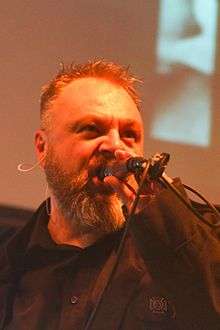Signal Aout 42
| Signal Aout 42 | |
|---|---|
 Wave-Gotik-Treffen 2016 | |
| Background information | |
| Origin | Belgium |
| Genres | Electronic |
| Years active | 1980–present |
| Labels | LD Records, Alora Music, Out Of Line, Disco Smah, Music Man Records, SPV GmbH |
| Website | http://signalaout42.wix.com/sa42 |
| Members | Jacky Meurisse |
| Past members |
Damien Vandamme Luc Vandamme Rudy Garyn |
Signal Aout 42, also known as SA42, is a Belgian band.[1]
Background

When they started,back in 1981,Signal Août 42 (which was simply called SIGNAL) was the project of a bunch of school mates (Jacky Meurisse,Damien and Luc Vandamme)who decided to get on stage to have fun and play improvised gigs…
In fact they didn’t have proper compositions but they were more like audio and vidual performances (industrial noises,chainsaw,metal barrels…played to rhythms generated by drum machines and synthetic sound atmospheres,the whole thing being made in a DIY style,tinkering around with home made or borrowed instruments.
Over the years and performances,and due to many jokes about the name « Signal » (which was also the name of a famous brand of toothpaste),Signal changed its name to Signal Août 42,in connection with the date when the German propaganda publication in the second world war came out,whose front cover we used for the posters announcing our concerts.
With his first salary in 1985 Jacky Meurisse, bought a bit of equipment,including the famous TB303 (Bass Line by Roland) and TR 606 which enabled hem to write the first tracks worthy of the name: Pleasure and crime,lovely trees that fortunately were released as 12″ singles by Disco Smash : the maxi single was an immediate hit in underground clubs worldwide !
Pleasure and crime still is a true EBM (Electronic Body Music) classic today.
After the success of the first single,he got back into composing for a new 12″ single « Girls of Vlandereen »,actually it was a nod to his wife who is of Flemish origin.
This maxi single also quickly became a true classic in this genre.
The success of these two records naturally lead to the writing of an album.This first opus was called « Pro patria » and remains as a cult record in the mind of alternative electronic music fans !!!
Being a pioneer in the EBM and New Beat style allowed me to work on several projects such as AMNESIA that were quite successful at the time .
So in 1988 it was a natural move for him to invest in a recording studio and he became a professional musician.Thus he could give himself the means to create new tracks for SA42.The studio was located on 22 rue du Fort in Comines.By the way that’s where I composed the smash hit « Le Dormeur » for one of his side projects that was more charts oriented….Pleasure Game !!
It’s also the place where the second album « Contrast » saw the light of day as well as the 12″ singles « Submarine dance » « To talk nonsense » « The right thing » and « Carnaval » which all became EBM New Beat classic tunes.
At that time Signal Aout 42 was composed of Damien Vandamme who gave constructive ideas and who was in charge of visuals (graphics,record sleeves…) for the band,Jean Luc Szekanecz who took part to the writing of a couple of 12″ singles and to a few gigs,and Luc Vandamme for live percussions.
From 1990 to 1995, Jacky Meurisse relocated the studio and worked exclusively for Disco Smash-Blackout Records and wrote several successful tracks for side projects (well…had to make a living) like PLEASURE GAME,LE PARK, DJPC,AMNESIA,BORIS…while keeping his passion for SA42 and I released a 3rd album « Conviction ».
In 2007 after a hiatus of 10 years SA42 is back with a 4th album "Transformation"
In 2010,the 5th album « Vae Victis » and in 2013 6th album "Inspiration" completed the discography.
Discography
Albums
- Pro Patria – 1989
- Contrast – 1990
- Conviction – 1993
- Transformation –2007
- Vae Victis – 2010
- Inspiration - 2013
Singles
- "Pleasure And Crime"
- "Girls of Vlaanderen"
- "Pleasure and Crime" (Remix)
- "Carnaval" (Acid Mix)
- "Submarine Dance" (Remix)
- "Right Thing"
- "Dead Is Calling"
- "I Want To Push"
- "To Talk Nonsense"
- "Waterdome"
- "The Last Quest"
External links
| Wikimedia Commons has media related to Signal Aout 42. |
References
- ↑ "Território da Música: Machina Redux traz Signal Aout 42 ao Brasil" (in Portuguese). Território da Música. 23 September 2009. Retrieved 7 January 2012.